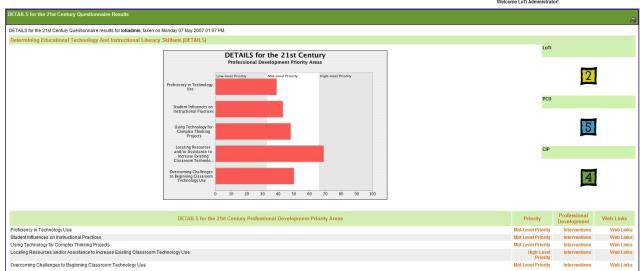Background
If I go back over 15 years ago, when I was first starting out in my doctoral studies, I was concerned about how technology fit into education. As a technology coordinator for a school district, I saw more technology being introduced into the district without a clear path of direction as to integrating the technology into the curriculum. Numerous computers were purchased to place in the computer labs and classrooms. However, the key part that was missing in this process was the lack of professional development needed to integrate this new technology. As I completed my doctoral studies and began to focus on my dissertation, I wanted to look at a way to prepare teachers better. In planning any professional development, I needed to remember Bloom's Taxonomy. Too often, technology was used in lower levels of Bloom's.
 Bloom's Taxonomy
Bloom's Taxonomy
At that time, I needed a way to measure where teachers were with integrating technology into their classrooms. Fortunately, I heard about LoTi (Levels of Technology Innovation) from my advisor. LoTi survey was a self-assessment tool that allowed teachers to measure several factors: 1) Proficiency in Technology Use; 2) Student Influences on Instructional Practices; 3) Using Technology for Complex Thinking Skills; 4) Locating Resources and/or Assistance to Increase Existing Classroom Technology; and, 4) Overcoming Challenges to Beginning Classroom Technology Use. The other aspect of the survey was the results in three categories (noted in the picture below). The first score is the LoTi (Level of Technology Implementation), the PCU (Personal Computer Use), and CIP (Current Instructional Practice). As I began to put the pieces together on what the focus of my dissertation was going to be I realized if I was going to focus on technology integration, I needed a tool to measure it. However, integration was deeper than having teachers or students use computers. Technology integration had to be project-based and student-centered with an understanding of multiple intelligences. So, in the middle of my doctoral work and being the technology coordinator, I went off to train to become a LoTi-certified mentor.
 LoTi Results
LoTi Results
Upon completing my certification, I meet with administrators to explain to them how the LoTi survey could be a useful tool to help plan any professional development in the future. I asked them to imagine using the results to plan in-service days better. So, if the results showed a teacher that was more student-centered in their approach but lacked technology knowledge, a professional development plan could focus on the technology aspects of teaching. On the other hand, if a teacher were tech-savvy but took more of a teacher-centered approach, their professional development would be to work with them on developing a more student-centered approach. What of the teachers tended to give worksheets to the students? Professional development could focus on project-based learning. The goal would be to get teachers at a LoTi level (see below) of 3 or above.
 LoTi Levels
LoTi Levels
The experience up this time, when it came to professional development, was to take all of the teachers and put them in a computer lab, throw a bunch of software at them, and have them walk away at the end of the day knowing how to use it. For the more advanced users, they would get bored or impatient and start to tune out. You would see them checking their email or surfing the web. Those less experienced teachers would become overwhelmed and feel guilty about holding everyone back from moving forward. Needless to say, this often resulted in teachers scrambling around to each other asking, "How do you do ....?" or "Where do I find ...." Meanwhile, back at my meeting with administrators, I emphasized not to go through with the survey if we wouldn't use it to plan professional development better. Unfortunately, that advice was ignored. Teachers took the survey, the information was gathered, and then a report was given to the Board of Education on the results. After that, the district continued to provide professional development just as it had in the past.
Planning and Implementation
If your school district is looking for a better way to integrate technology into the classroom, knowing what to do and how to get started is imperative. If you are going to make a commitment, you must devise a plan. The level of commitment must go beyond what "looks good." Whether you choose to use the LoTi Survey or another tool, an assessment of where your teachers are regarding technology integration is necessary. Also, you must be committed to providing professional development to teachers. As noted above, this does not mean the one-day in-service session. A long-term plan must be implemented. A note of caution if you decide to use the LoTi Survey - encourage teachers to be honest in their self-assessment. Remind teachers this survey is about where they are now, not where they want to be. Be Honest!
Once the teachers have taken the survey, it's time to assess the results and start planning for the future. As you begin to plan your professional development, you will now have a tool to assist you. Need assistance with this process? That is where Technology in Education Online comes into the picture. My doctoral dissertation was based on technology integration, Using Moodle to Leverage Technology Integration.
What Technology in Education Online can do:
- Coordinate and Implement the LoTi Survey within your district.
- Assist the district in analyzing the data and planning professional development for teachers.
- Meeting with district teachers to go over survey results.
- Provide consultation services.
- Conduct on-site workshops based on the results of the LoTi survey.
- Provide in-class collaboration.
- Face-to-face meetings with teachers to help integrate technology into their classrooms.
If these ideas get you excited and your district wants to move forward, please contact Technology in Education Online. Want to get a sense of my experience, please take a look at the abstract of my dissertation - Abstract - EPP.
